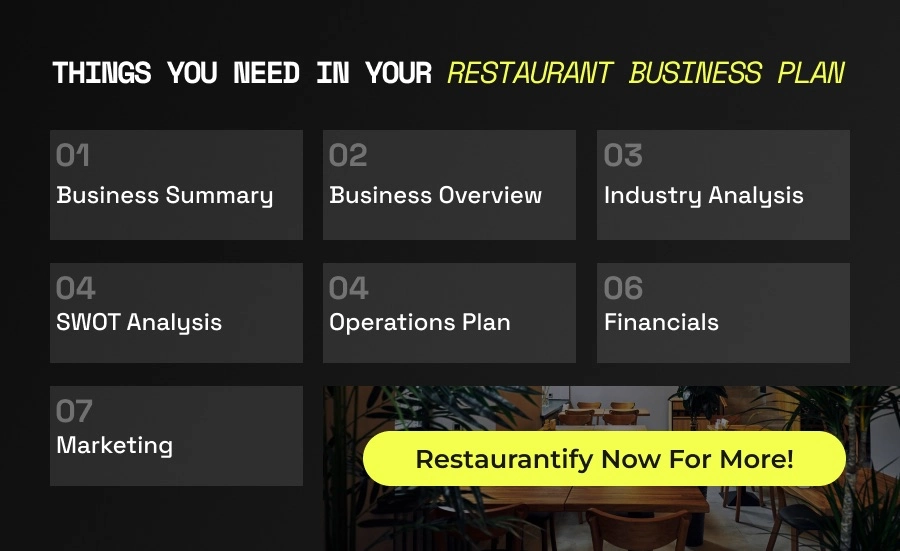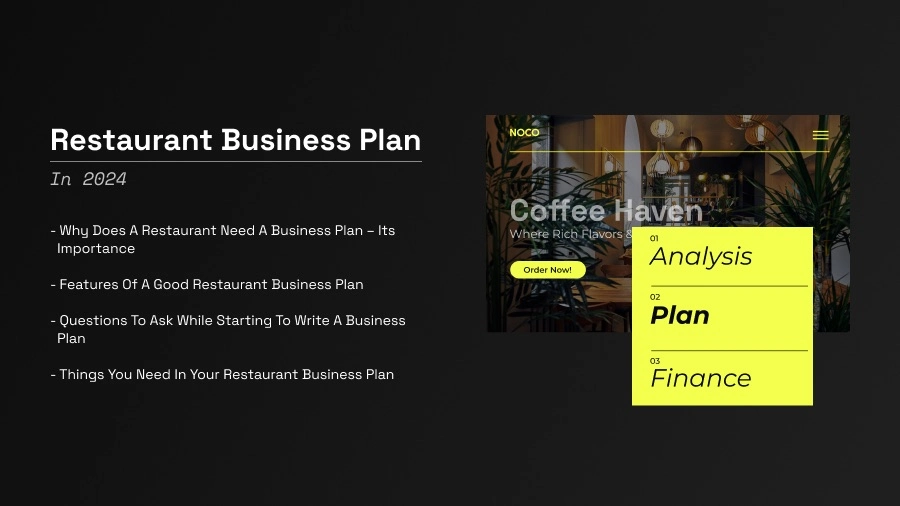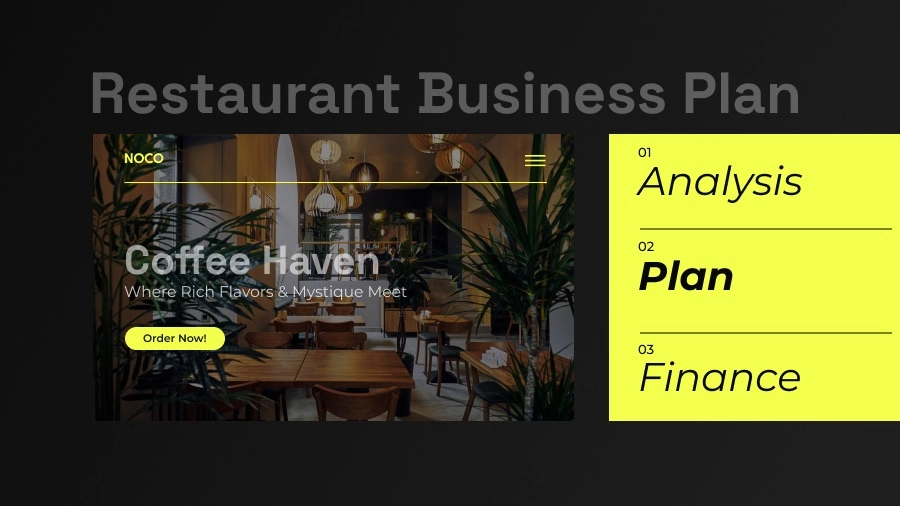Restaurant Business Plan in 2024
If you are considering opening a restaurant, you must start by drafting a restaurant business plan as it is a reliable and perfect way to visualize the business idea and test its viability much before launch.
Whether you are a seasoned restaurant owner or a first-time entrepreneur, this blog will be useful for you, providing you with details of a restaurant business plan and how to draft one in 2024.

A recent study states that the restaurant industry has a 20% success rate. This means that 80% of the restaurants fail within the first five years.
Not just restaurants, every new venture needs a business plan. A business plan is essential to achieve clarity in all aspects of the restaurant business. A good business plan will push you to question yourself about the business, your proposed business model, value proposition and overall possibilities of success.
With the business plan as a roadmap, a restaurant owner can spot potential problems early. It contains details of what can be expected and what is likely to happen. It creates accountability for the restaurant owner and partners (if any).
Without a business plan, it is difficult for a restaurant to get investors. Even if funding is received, the absence of a detailed plan will only lead to failure.
Features Of A Good Restaurant Business Plan
Although it is meant for internal use, a restaurant business plan must be drafted in a systematic manner. It must be structured in an easy, understandable, logical and feasible manner. It must be sustainable in the long run.
A restaurant business plan outlines what the restaurant is about, where the owner plans to take it, what are the plans to achieve those goals and the period that it is likely to take. It considers all opportunities and pitfalls of the restaurant business well.
Questions To Ask While Starting To Write A Business Plan
Drafting a restaurant business plan is definitely a daunting task. A restaurant owner will need a lot of information and an eye for detail to ensure that the final copy is not just comprehensive but effective too.
To address this difficulty, a restaurant owner can start by answering a number of general questions first. This will help in narrowing down the information that must be included in the plan, making the preparation process less cumbersome.
The questions that can be asked are:
- What is the major problem that the restaurant’s product or service will solve?
- What is the niche that the business will fill?
- How will the existing problem be solved by the business?
- Who are the customers for the restaurant?
- How does the restaurant intend to sell its food to those customers?
- What is the market size?
- What is the business model that will be followed?
- How does the business intend to make money?
- Who are the restaurant’s competitors?
- How will the business win over its competitors to capture the market?
- What are the plans for business expansion and growth?
- Who will head and run the business?
- What qualifications does that person possess to run the business?
- What are the possible weaknesses and threats?
- What can be done to reduce the weaknesses and address threats?
- What is the requirement for capital and resources?
- What is the business’ historical and projected financial statements?
Things You Need In Your Restaurant Business Plan
A tip for effective restaurant business plan writing is to approach it in structured parts. For instance, even though a restaurant business plan should start with an executive summary, it is suggested to draft it at the end. This is because when you reach the end of formulating the restaurant business plan, you will have a concrete idea of every element that the plan comprises, and things that are yet to be included.
Similarly, the SWOT analysis must be written before the Industry Analysis as it is necessary to know the strengths and weaknesses to determine the competitors and your designated place in the industry.
A famous American entrepreneur is quoted as saying, “Good business planning is 9 parts execution for every part of strategy.”
Although every element in a restaurant business plan is interdependent, the success of one part cannot be assumed while ignoring the other. Every step needs equal importance and attention to attain comprehensive success.
Restaurant owners can gain easy and free access to business plan templates online. They can be created on your own without any specific expertise. All that a restaurateur must know is how to write a restaurant business plan. Following are the top components of a restaurant business plan:

1. Business Summary
The restaurant plan should start with an overview stating the summary of the restaurant concept. This would perform the function of introducing the business. Since it acts as a gateway to the core of the restaurant business plan, it must be done right. It is also essential for the summary to be short and precise as the name suggests.
This summary must comprise the mission statement, a review of the restaurant’s legal hierarchy and ownership, a precise history if the restaurant already exists in another location and the plans for future expansion. The restaurant business plan provides a quick glimpse of the business and the all-round strategies
2. Business Overview
The next step is to describe the restaurant concept. While writing the overview, you must clearly define the USP of the business and why it is sure to work. One must provide a concrete reason behind the restaurant concept, why the concept will be successful, how you plan to make it a reality, the cost that will be incurred and the probable return on investment.
The three aspects of the business overview of a restaurant plan are:
- The layout of the restaurant or type of service – Mention the format and design that should sync with the restaurant format
- Sample menu – State what you plan to offer. Create a simple list of items with half and full prices. Balance the menu between cold or hot and heavy or light
- Management team – Include details of the owner, general manager and head chef along with each member’s responsibilities for greater clarity.
3. Industry Analysis
The restaurant owner must identify target customers, their spending behavior, purchasing ability and other related demographics. One can serve the customers better by doing so. The industry analysis consists of:
- Location Analysis – There should be a logical connection between the restaurant location, its format and target audience. The analysis should describe the market conditions that exist in the location or area that has been selected. The location should be easily accessible, have ample parking space, adequate seating, storage area and be Google Map friendly. Information about demographic statistics, description of local industry and competition should be included.
- Target Audience Analysis – No restaurant can appeal to everyone. The restaurant owner must be aware of the audience that the business will serve, the class the people would belong to, their food-related preferences and habits and spending capacity. This analysis will help to know which segment of the population is most likely to come to the restaurant.
- Competition Analysis – The restaurant industry is known for its high competition. If the competition analysis leads to you realizing that there are no competitors in the area, it could mean that none of them were able to survive in that market. This would mean that you must reconsider the prospect of setting up a restaurant in that area. This analysis should identify and include both present competitors and prospective ones.
4. SWOT Analysis
A SWOT analysis is nothing but understanding and stating the Strengths, Weaknesses, Opportunities and Threats of the restaurant business in the business plan. This step identifies internal and external factors that impact the restaurant’s future. It not only warns you about possible mistakes that can be committed and the weaknesses that might affect the business, but also gives a detailed insight regarding the strengths and opportunities that can be leveraged for business development.
- Strengths – They are the strong points driving the restaurant’s growth. Example: Restaurant USP, competitive pricing, location, prompt service, etc.
- Weaknesses – They are the weak links that reduce the growth pace of the restaurant. Nevertheless, these not good factors can be worked upon. Example: being an unestablished brand identity or having untrained staff.
- Opportunities – They are the upcoming trends that not many or no one has utilized to their benefit. When made use of at the right time, they elevate the business to the next level. Example: Enjoy a first mover advantage with a new concept in the area.
- Threats – They are external factors over which you have no control, and which pose potential danger to the restaurant business. Prepare in advance to tackle them by including them in the restaurant business plan. Example: New restaurant competition or sudden shortage of supplies.
5. Operations Plan
This is an integral part of the restaurant business plan with information about how the restaurant would function on a day-to-day basis.
- Staff Management – Another significant challenge is to find perfectly skilled people to run the restaurant. The restaurant industry is a labor-intensive business, making the team the backbone for success. The staff must be treated with utmost care and rewarded appropriately when the business is making profits. Include points like the necessary staff strength in every section, entire recruitment process, job descriptions and staff training manual. Broadly, a restaurant would require kitchen staff, service staff and management staff. Include a mixed culture of people to create a backup during festive seasons and have an element of diversity in the restaurant. Staff must be trained on a regular basis to keep them updated with industry standards. Create a training manual and train the staff accordingly.
- Customer Service – The restaurant business plan must necessarily state the kind of service that would be provided in the restaurant as it influences the entire customer experience. The type of customer service must be relevant to the restaurant format. You could choose between a Table d’ hotel, A la carte, Silver service or Platter to Plate.
6. Financials
While writing the financials of a restaurant in the business plan, it is important to remain practical and realistic. Having a personal financial statement and balance sheet in place with the regular cash flow statement is necessary to reach break-even, stay afloat and eventually make profits. Since money is slow for a new restaurant, the owner must remain conservative during the initial days. Cash should never be taken for granted. One must also not be over ambitious and expect good revenue from the day of launch and a similar proportion in the upcoming days.
The following must be included in the financial section of the restaurant business plan:
- Cash Flow Statement – It is a record of where money comes from and where it goes. It is crucial for planning the restaurant’s future.
- Capital – This section will provide information about your financials, your partner’s financials, how much they would invest in the business along with the contingencies that may arise and how they would be managed. Allocate funds for operating expenses, fixed expenses, marketing and various other sections of the restaurant. Mention the approximate time when you expect your break-even.
- Expenses – This includes capital expenses (fixed in nature and non-recurring), operating expenses (incurred to run the restaurant like salary, equipment depreciation, rent, electricity, etc.), cost projection (to be done once every 6 months), revenue projection (understanding the probable amount of footfall), revenue per person (analyze how much one person will be able to earn on an average) and Statements of Income (calculate the ROI).
Experts suggest that restaurant owners be conservative when drafting the revenue projection and generous while writing expense statements.
7. Restaurant Marketing
Since the competition in the Food & Beverage industry is getting fiercer day by day, including marketing plans in the restaurant business plan is an essential step. Have a precise picture of the market strategy in advance and prepare a budget for both online and offline marketing. Allocate a set percentage of your earnings for marketing activities.
a) Restaurant Launch – Have a soft launch with friends and family before organizing the actual official launch party. This will help you get unadulterated feedback. This will provide you with the buffer time to get enough cash in hand and the experience for a successful launch. Invite politicians, journalists, popular food bloggers and critics for the hard launch.
b) Online and Offline Marketing – The marketing strategy should contain plans for both online and offline platforms and be determined by contemporary market trends. Define the restaurant’s specialties and mention how you plan to stay unique despite the heavy competition in the area.
- Online Marketing: Use the restaurant website, blogs, various social media platforms and email marketing for the restaurant’s online marketing activities.
- Offline Marketing – You could engage with food bloggers, host events, advertise through physical signages and billboards, distribute pamphlets, arrange for radio mentions and advertise on television or in newspapers.
c) Customer Relationship Management – One of the major challenges that restaurants face today is to cater to changing eating habits and diverse dietary preferences. A restaurant owner must understand and analyze the evolution of customer behavior, food and dietary preferences and eating patterns to serve them better. Even before customers start walking in, work out a way to accumulate customer data and develop business. Make specific mentions of the channels that will be used to acquire customer data and the strategies that will be used to engage with future guests.
This blog would have been of great help if you were looking for solid guidance on how to make a restaurant business plan that works well in 2024. For further assistance in restaurant website building and digital marketing, get in touch.
KEY TAKEAWAYS

